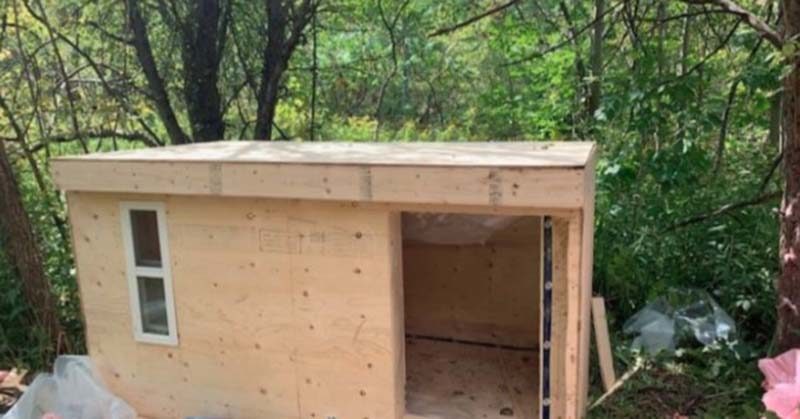Some years, winter can prove to be the most unforgiving season there is. For many in the homeless community, they need as many resources as they can to survive the blistering cold. Unfortunately, many of those experiencing homelessness do not have access to what they need to stay safe. Thankfully, 28-year-old carpenter Khaleel Seivwright has created a series of mobile shelters for the homeless this holiday season. Unfortunately, there is a legality problem that still remains. The city of Toronto, where Khaleel resides, still needs to approve Seivwright’s mobile shelters if they are to be used at all.
How These Mobile Shelters Are Made
Seivwright’s mobile shelters for the homeless cost around $1000 dollars in materials. It takes him about eight hours to fully construct one of these shelters. The frame of the house is made of wood boards to keep the structure stable. The insides of the mobile shelter are lined with a thick membrane of fiberglass that’s used as insulation. The small shelter unit has a door, a small window, and spinning caster wheels that allow it to be mobile. (1)
Seivwright receives donations from the community of Toronto to make these mobile shelters for the homeless. Regardless of cost and effort, Seivwright says that he’s happily given the first few he’s created away for free. After delivering a few of the mobile shelters, some of them expressed how grateful they were for Khaleel’s gift. Although some have offered him money, Seivwright simply explains it was a community effort and has been paying for the project mostly through an online fundraising campaign, where he has collected around $2,500.
Read: Kenneth Capron Wants to Buy Old Cruise Ship and Turn It into Homeless Shelter
Why Mobile Shelters Are Important
Seivwright started this project at the beginning of October. Living in Toronto’s harsh winters, Seivwright claims that he knew he had to do something about the homeless issue within the coming cold months.
“It just seemed like something I could do that would be useful because there’s so many people staying in tents. I’ve never seen so many people staying outside in parks, and this is something I could do to make sure people staying outside in the winter could survive.” Seivwright says. (1)
Due to the increased homeless population because of COVID-19, Seivwright believes the time for action is now. Toronto’s shelter resources are already spread very thin and could prove to get worse into December. As the unemployment rate continues to increase, there is concern that homelessness will increase. On top of rising COVID numbers, there is also a valid concern of overcrowding shelters. Seivwright’s mobile shelters for the homeless could act at least as a partial remedy for this very horrifying reality. (1)
What Will It Take To Become Legal?
If Seivwright’s mobile shelters are approved by the city, they could be produced at a much higher scale. Even though he continues to fight to be able to produce these shelters, it’s going to take the whole community to convince the city. Many have already begun to voice their opinions about how chaotic winter might be this year.
Long time street-nurse, Cathy Crowe, told CBC Toronto, “It’s going to be catastrophic. We have not yet seen the wave of evictions from people in unstable, unaffordable housing. People are trickling into homelessness now, but it’s going to be like nothing we’ve ever seen in our lifetime.” Many advocates in Toronto share Crowe’s sentiments. Understandably, the community is demanding a capacity increase for homeless shelters. (1)
The city of Toronto claims that they plan to incorporate 560 additional spaces for the homeless this winter. However, Gord Tanner, director of homelessness initiatives and prevention at the city’s Shelter, Support and Housing Administration, says that the system is very full and very busy. (1)
The Future Of Mobile Shelters For The Homeless
Seivwright says that bylaw enforcement doesn’t distract him from making mobile shelters for the homeless. To Seivwright and so many others, this isn’t just about money. This is a matter of life and death for a lot of people this winter. He states, “This is what I know how to do, this is what seems to be viable, so I’m going to continue to do this.” (1)
Individuals, such as Cathy Crowe, are firmly rooted in their stance on homelessness this year. Crowe states, “I don’t like this idea of coffin-like structures as a solution — I really, really don’t — but we’re not being given an alternative. Innovative, creative solutions like this are going to have to happen.” (1)
The city of Toronto, however, says that they don’t intend on pursuing mobile shelters for the homeless. The reason why is because they fear there may be a fire hazard element to the occupants of the shelters. Instead, they are more focused on getting individuals inside safe spaces where they can warm up and get a hot meal. Encouraging the community of Toronto to utilize the available resources already put in place. (1)
Keep reading: Finland Ends Homelessness and Provides Shelter For All in Need.

